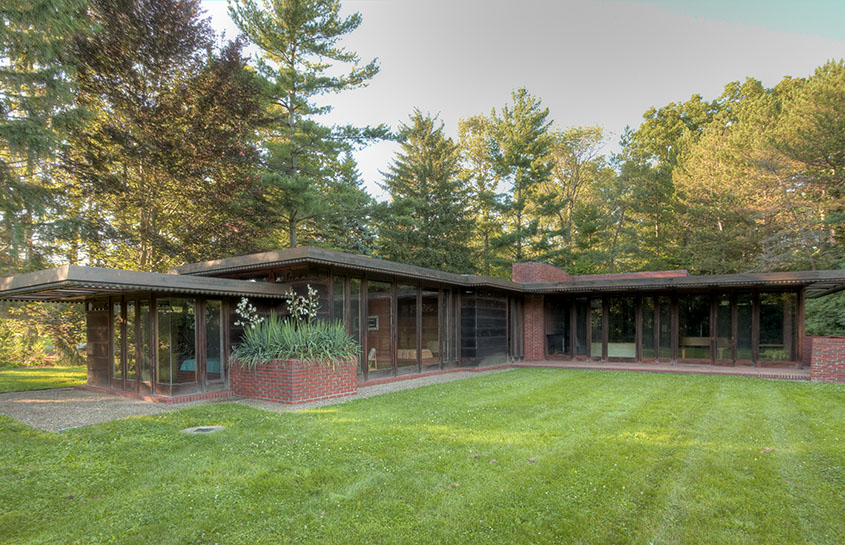
Every landmark house needs a champion, and the Weltzheimer-Johnson House found one in Ellen Johnson. A renowned art aficionado and Oberlin College professor, Johnson purchased the 2,100-square-foot ranch home in 1968 with hopes of restoring it to its former Frank Lloyd Wright aesthetic.
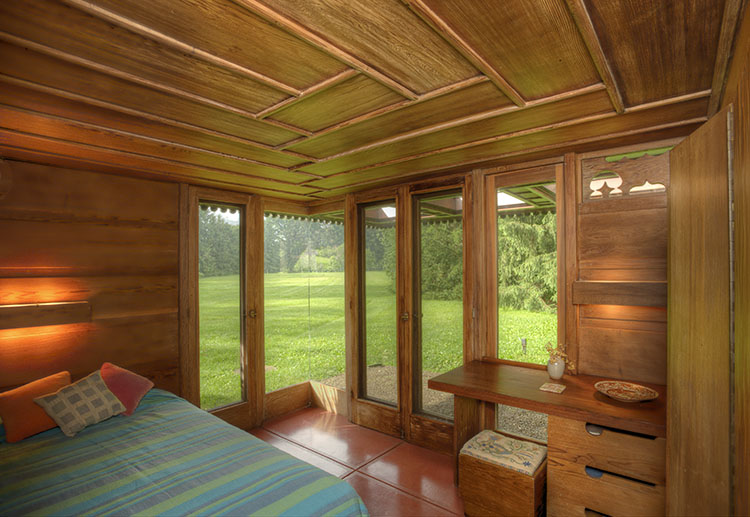
First built in 1948 as Ohio’s first Usonian, the home was originally commissioned by Charles and Margaret Weltzheimer. After Margaret’s death in 1963, the home went through two more owners, the latter of whom was a real estate developer who saw fit to make some “creative” alterations.
“In his mind, he was trying to make the house more appealing for sale,” explains Jill Greenwood, curator of education at Oberlin College’s Allen Memorial Art Museum. “While researching, I found a quote in which [the developer] said that he felt Frank Lloyd Wright would have appreciated his modifications, but the changes he made go against the core design principles of a Usonian home.”
Reclaiming a Landmark
Some of those changes to the Weltzheimer-Johnson House included removing part of the built-in bookshelves to add windows down the long hallway; painting the redwood exterior of the home red; installing white Formica countertops in place of the original red linoleum; and subdividing the land (once three acres) into four plots. By selling a prized Richard Diebenkorn painting, Johnson was able to reclaim the home and restore its Frank Lloyd Wright pedigree.
“With the proceeds, Ellen was able to get enough money to purchase the house and the [adjacent plot with the] front part of the lawn closest to Morgan Street,” says Greenwood. “She was aware that portion of the land was part of the aesthetic.”
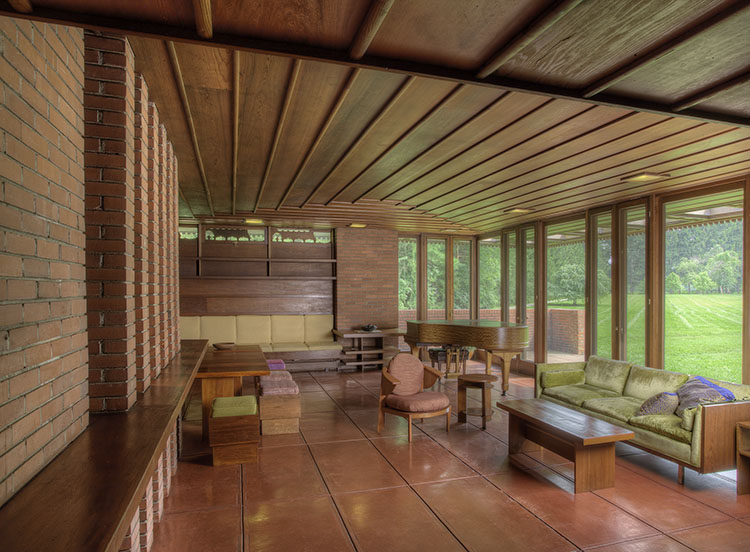
Johnson’s Generous Epoch
In the 24 years Johnson resided in the Weltzheimer-Johnson House, she reversed many of the alterations. For instance, she restored the hallway with its original perforated boards and removed the exterior paint to reveal the original redwood (an important distinction as the Weltzheimer-Johnson House is the only redwood Frank Lloyd Wright house outside of California).
She managed to have a little fun, too, hosting well-known artists and creatives such as Claes Oldenburg, Jorge Luis Borges, John Cage, and Christo. “In addition to saving the house, Ellen was excited to have the opportunity to live in it, and she was famous for inviting New York City artists to visit the home,” says Greenwood. “She interacted with a lot of the big movers and shakers of the 1960s.”
Upon her death in 1992, Johnson bequeathed the Weltzheimer-Johnson House to Oberlin College. The college offers house tours and educational programming to the public (though it is currently closed due to COVID-19).
“Ellen really envisioned artists staying in the house and classes taking place there. She wanted it to be a venue to extend the experience to Oberlin College students and the greater public,” says Greenwood. “That was part of her mission.”
One Unique Usonian
When visiting the property, it’s easy to understand what Johnson saw in the home. The Weltzheimer-Johnson House boasts a number of distinctions, being larger than most Usonian homes with four bedrooms. Round wooden balls also line the structure’s fascia—a somewhat common hallmark of Frank Lloyd Wright architecture—but “never in the exact same way you see it at the Weltzheimer-Johnson House,” says Greenwood. “They are placed very close together and go all the way around the house, which makes it unique.”
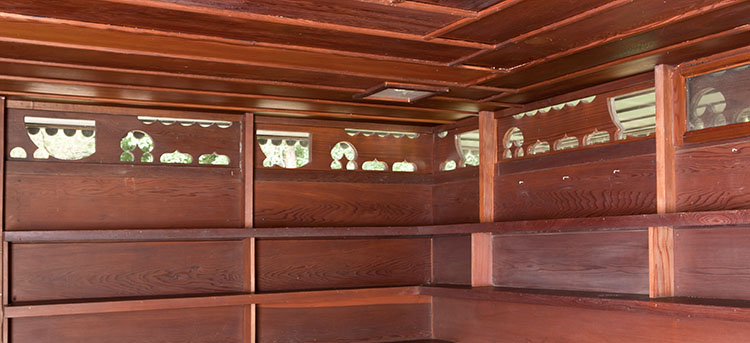
Greenwood adds that the perforated boards found throughout the home differ aesthetically from most Frank Lloyd Wright properties. While most perforated boards Wright used are angular with what Greenwood calls a “Southwest feel,” the perforated boards inside the Weltzheimer-Johnson House are round and curvilinear.
“The perforated board designs in the blueprints are not the ones executed in the house, so [on-site Taliesin apprentice] Ted Bower may have redesigned them,” says Greenwood. “This isn’t your standard Usonian home.”
Also in the original blueprints was a piano, a nod to the Weltzheimers’ love of music. (According to Greenwood, Johnson was able to bring that back to fruition with a piano on loan from Oberlin College’s music conservatory.) The Weltzheimers’ legacy is also felt in the fireplace in the master bedroom, which features several rare “Nelsonville star bricks” from Charles’ hometown of Nelsonville, Ohio. Letters and correspondence between the Weltzheimers and Frank Lloyd Wright can also be read when visiting the home.
Today the Weltzheimer-Johnson House lives on as one of 48 Frank Lloyd Wright homes open to the public. While Johnson wasn’t able to fully bring it back to its original state (“The kitchen is the room most modified from the original plans,” laments Greenwood), it remains a high point of interest thanks to Johnson’s patronage and dedication. Says Greenwood, “She saw it for the important architectural statement that it is.”
Did you know Frank Lloyd Wright’s son was also an architect? Read about him here. Or find more MCM gems in the Midwest such as Saarinen’s Miller House. Don’t forget to follow Atomic Ranch on Instagram, Facebook and Pinterest for more Mid Century Modern inspiration!
About the Contributor
Jen Jones Donatelli is a freelance journalist and Mid Century Modern devotee who lives in Cleveland, OH. Her work has appeared in publications including Los Angeles Confidential, Playboy, West Hollywood Lifestyle, Budget Travel, Robb Report, Thrillist, JustLuxe, and many more. In 2018, she and her husband purchased a 1950 mid-century ranch on Lake Erie and are always looking for the perfect pieces of MCM flair to enhance it — from sunburst mirrors to Mondrian-inspired placemats. For fun, she shares Mid Century Modern inspiration and homes at Mid Mod Midwest – give it a follow!

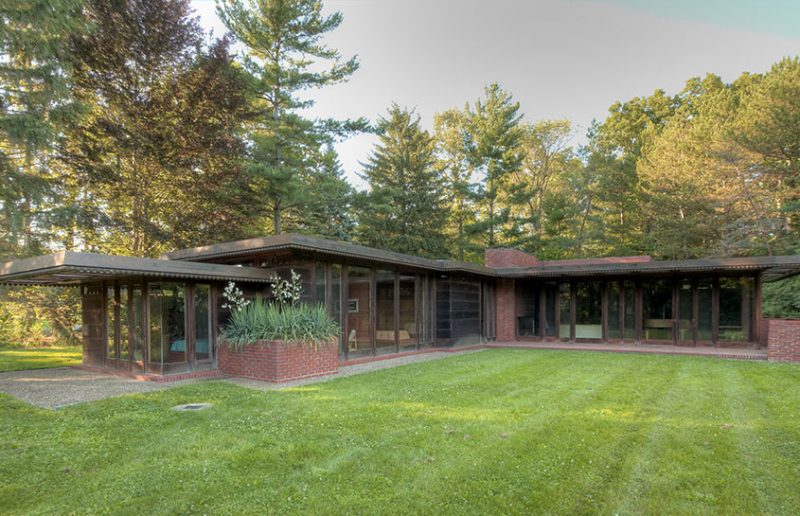












1 comment